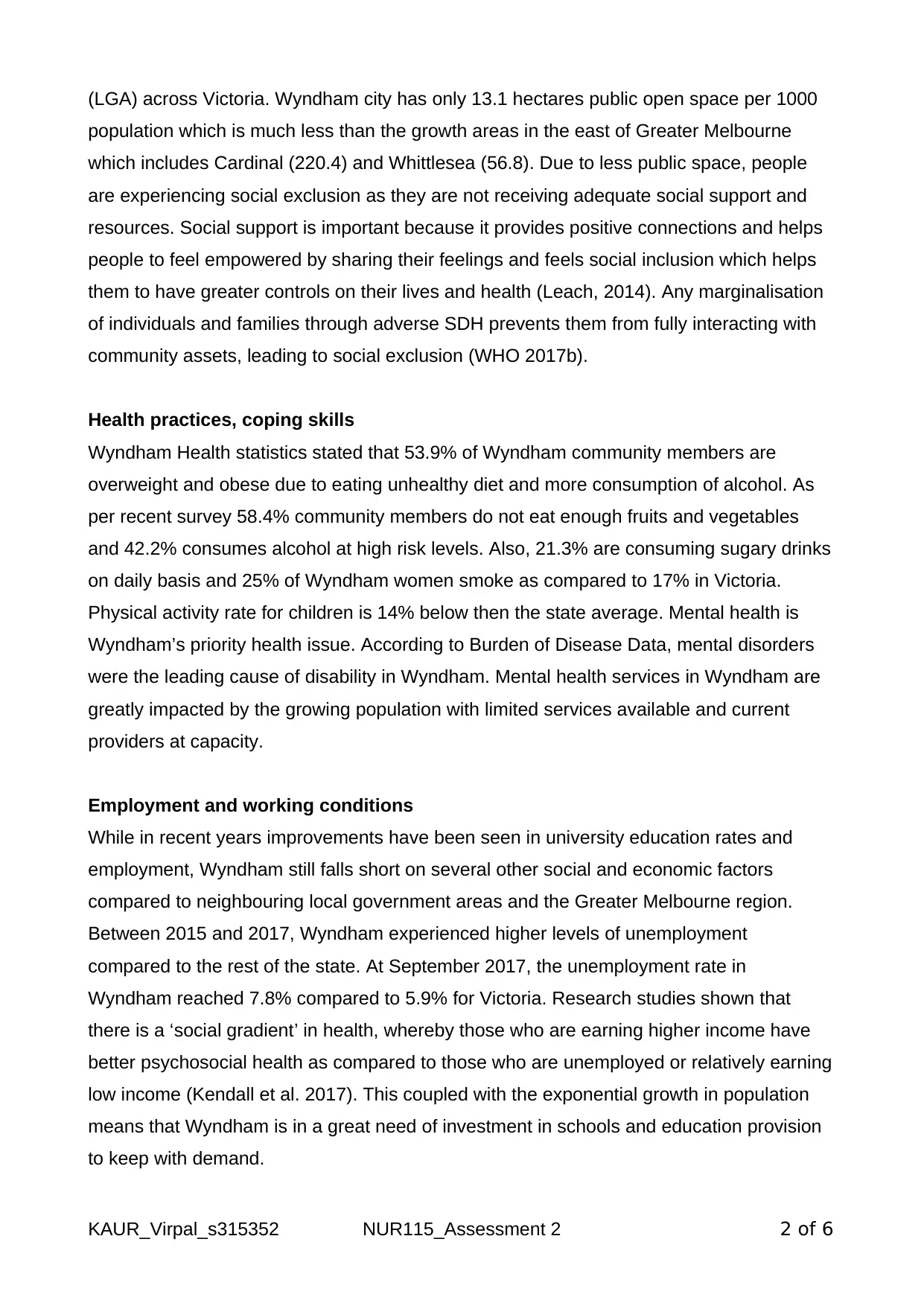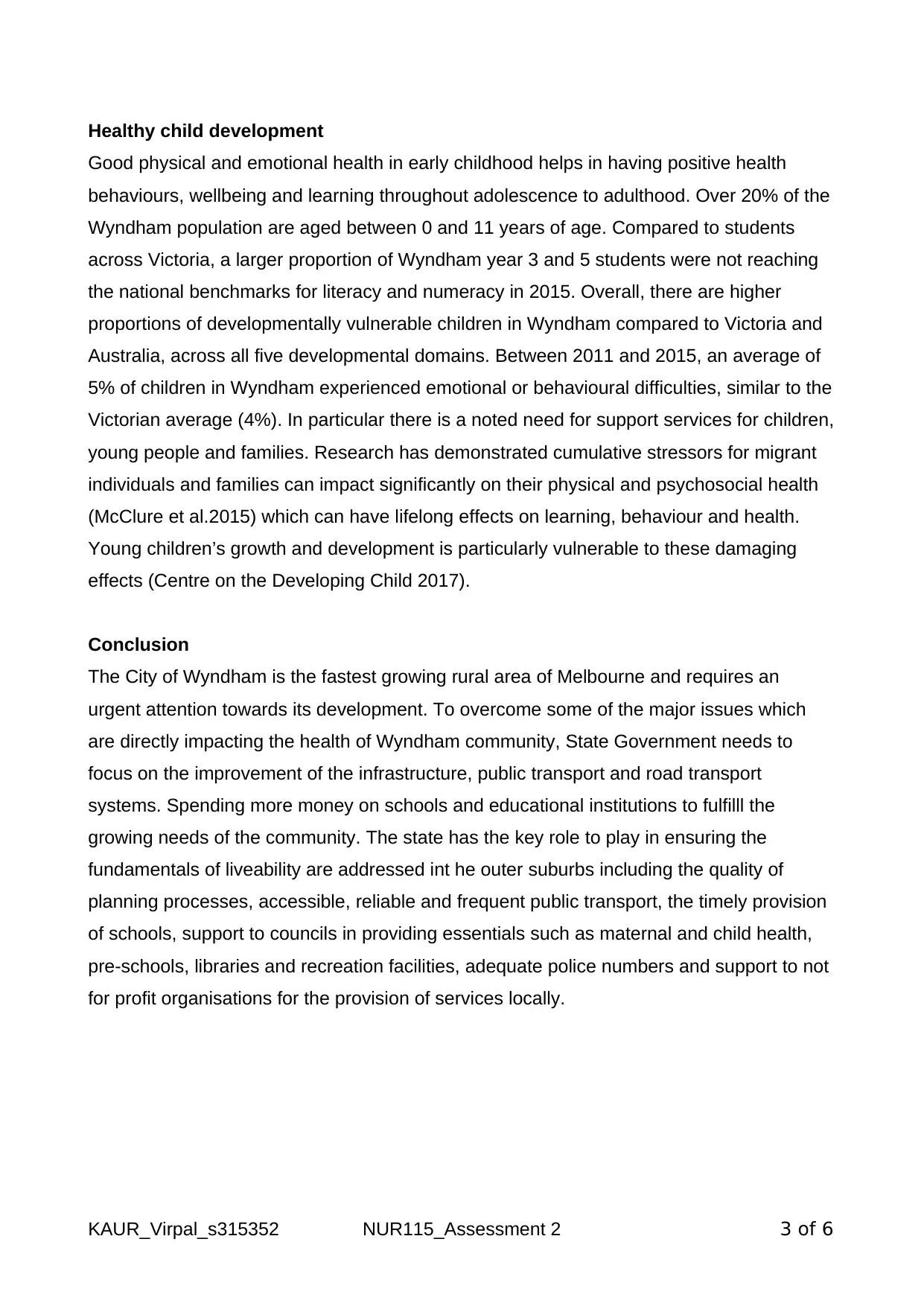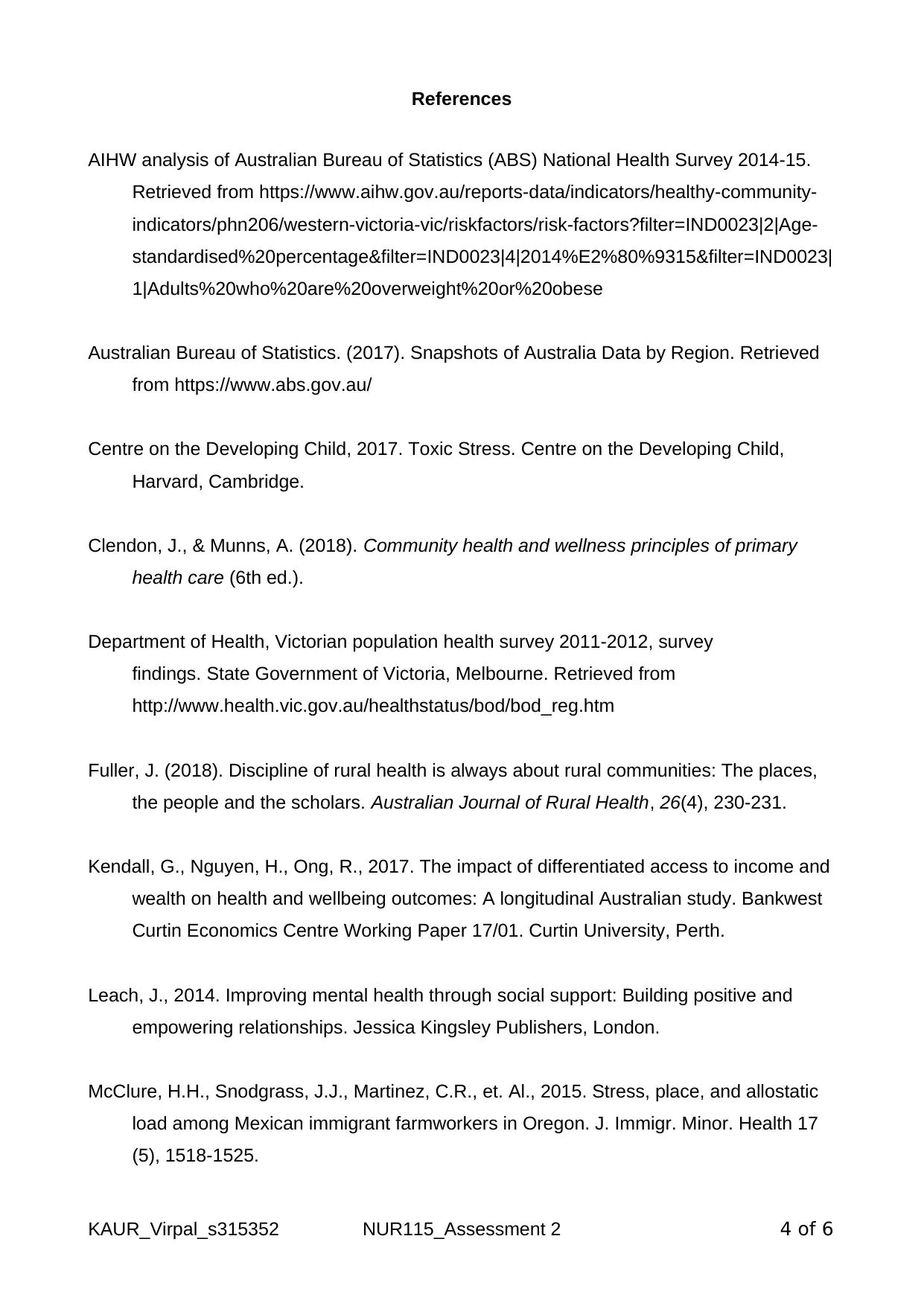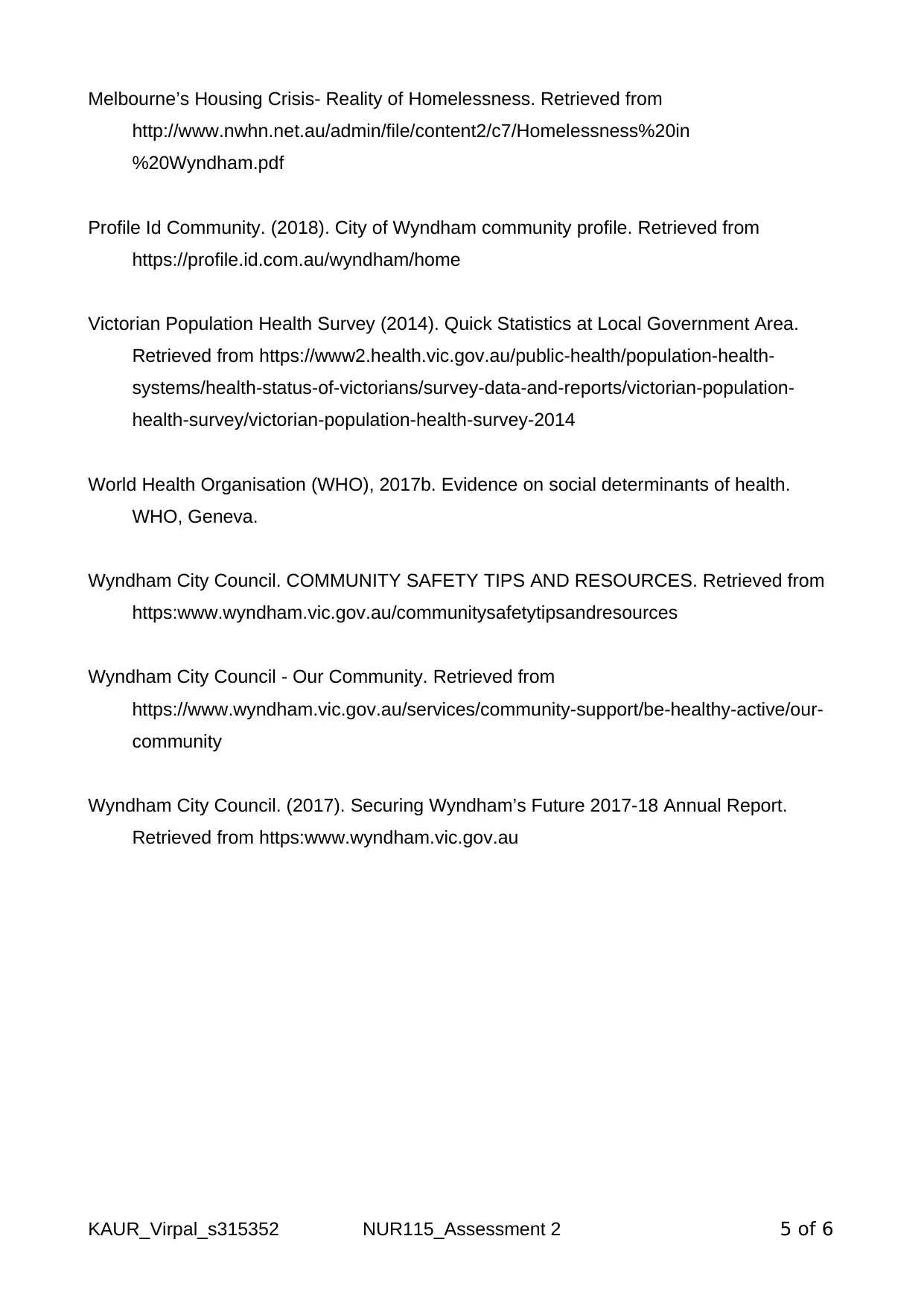Report: Social Determinants of Health Impacting Wyndham City Health
VerifiedAdded on 2023/01/17
|6
|1684
|42
Report
AI Summary
This report provides an analysis of the social determinants of health (SDH) impacting the community of Wyndham City, located on the western edge of Melbourne, Australia. It examines five key SDH: physical environments (including congested transport), social environments (lack of public space), health practices and coping skills (obesity, unhealthy diets), employment and working conditions (unemployment), and healthy child development (literacy and numeracy rates). The report highlights challenges faced by the growing population, including inadequate infrastructure, limited public spaces, and health issues related to lifestyle and socioeconomic factors. It emphasizes the need for government investment in infrastructure, education, and social services to address these issues and improve the overall health and well-being of Wyndham's diverse community, which includes a significant migrant and Aboriginal population. The report uses data from various sources, including the Wyndham City Council and the Australian Bureau of Statistics, to support its findings and concludes with recommendations for addressing the identified challenges.

Introduction
The City of Wyndham is located on the western edge of Melbourne, between the
metropolitan area and Geelong. Wyndham features 27.4km of coastline bordering Port
Phillip to the east. It is Melbourne’s one of six designated Victorian growth areas. In
Wyndham, Werribee River has been a significant place for Aboriginal people to build
community and share responsibilities for its land. Wyndham is the city where large
population of Aboriginals and Torres Strait Islanders resides. Wyndham is a multicultural
city, as per the recent report, just under 99% population migrated to Wyndham is from
overseas and 53 out of 100 residents speaks language other than English. The SDH
impact on migrant and refugees ability to engage with health systems. The Australian
Journal of Rural Health (AJRH) stated that the economic, environmental, social and
cultural viability constitute the health determinants of rural community. This report will
discuss five SDH that are impacting the health of Wyndham’s community.
Physical environments
As per the information received from the website of Wyndham city council, it has been
confirmed that Wyndham is the fastest growing area in the west of Melbourne due to which
roads and trains are more congested as more people are travelling to city for work. Roads
and trains in Wyndham are getting increasingly congested due to quick population growth.
In 2014 and 2015, 40% of morning peak hour services were carrying more passengers
than recommended. In 2014, 17% of Wyndham residents reported that at least one
member of their household travelled 90 minutes or more to get to and from work. This
figure increased to 27% in 2016 before decreasing to 17% in 2017.55% of households in
Wyndham have access to two or more vehicles, compared to 46% of households in
Greater Melbourne. In 2017, 5% of morning peak hour commuter trains on the Werribee
line are breaching capacity recommendations, down from 29% of services in 2016.
Congested transport system increasing the stress level of the community as people are
not getting enough time to maintain their health and family life which also causing the
increase in family violence.
Social environments
Wyndham community is facing challenges in their daily social life as there is not enough
public space available for the growing population in the area. Between 2011 and 2016,
Wyndham experienced the largest population increase of any Local Government Area
KAUR_Virpal_s315352 NUR115_Assessment 2 1 of 6
The City of Wyndham is located on the western edge of Melbourne, between the
metropolitan area and Geelong. Wyndham features 27.4km of coastline bordering Port
Phillip to the east. It is Melbourne’s one of six designated Victorian growth areas. In
Wyndham, Werribee River has been a significant place for Aboriginal people to build
community and share responsibilities for its land. Wyndham is the city where large
population of Aboriginals and Torres Strait Islanders resides. Wyndham is a multicultural
city, as per the recent report, just under 99% population migrated to Wyndham is from
overseas and 53 out of 100 residents speaks language other than English. The SDH
impact on migrant and refugees ability to engage with health systems. The Australian
Journal of Rural Health (AJRH) stated that the economic, environmental, social and
cultural viability constitute the health determinants of rural community. This report will
discuss five SDH that are impacting the health of Wyndham’s community.
Physical environments
As per the information received from the website of Wyndham city council, it has been
confirmed that Wyndham is the fastest growing area in the west of Melbourne due to which
roads and trains are more congested as more people are travelling to city for work. Roads
and trains in Wyndham are getting increasingly congested due to quick population growth.
In 2014 and 2015, 40% of morning peak hour services were carrying more passengers
than recommended. In 2014, 17% of Wyndham residents reported that at least one
member of their household travelled 90 minutes or more to get to and from work. This
figure increased to 27% in 2016 before decreasing to 17% in 2017.55% of households in
Wyndham have access to two or more vehicles, compared to 46% of households in
Greater Melbourne. In 2017, 5% of morning peak hour commuter trains on the Werribee
line are breaching capacity recommendations, down from 29% of services in 2016.
Congested transport system increasing the stress level of the community as people are
not getting enough time to maintain their health and family life which also causing the
increase in family violence.
Social environments
Wyndham community is facing challenges in their daily social life as there is not enough
public space available for the growing population in the area. Between 2011 and 2016,
Wyndham experienced the largest population increase of any Local Government Area
KAUR_Virpal_s315352 NUR115_Assessment 2 1 of 6
Paraphrase This Document
Need a fresh take? Get an instant paraphrase of this document with our AI Paraphraser

(LGA) across Victoria. Wyndham city has only 13.1 hectares public open space per 1000
population which is much less than the growth areas in the east of Greater Melbourne
which includes Cardinal (220.4) and Whittlesea (56.8). Due to less public space, people
are experiencing social exclusion as they are not receiving adequate social support and
resources. Social support is important because it provides positive connections and helps
people to feel empowered by sharing their feelings and feels social inclusion which helps
them to have greater controls on their lives and health (Leach, 2014). Any marginalisation
of individuals and families through adverse SDH prevents them from fully interacting with
community assets, leading to social exclusion (WHO 2017b).
Health practices, coping skills
Wyndham Health statistics stated that 53.9% of Wyndham community members are
overweight and obese due to eating unhealthy diet and more consumption of alcohol. As
per recent survey 58.4% community members do not eat enough fruits and vegetables
and 42.2% consumes alcohol at high risk levels. Also, 21.3% are consuming sugary drinks
on daily basis and 25% of Wyndham women smoke as compared to 17% in Victoria.
Physical activity rate for children is 14% below then the state average. Mental health is
Wyndham’s priority health issue. According to Burden of Disease Data, mental disorders
were the leading cause of disability in Wyndham. Mental health services in Wyndham are
greatly impacted by the growing population with limited services available and current
providers at capacity.
Employment and working conditions
While in recent years improvements have been seen in university education rates and
employment, Wyndham still falls short on several other social and economic factors
compared to neighbouring local government areas and the Greater Melbourne region.
Between 2015 and 2017, Wyndham experienced higher levels of unemployment
compared to the rest of the state. At September 2017, the unemployment rate in
Wyndham reached 7.8% compared to 5.9% for Victoria. Research studies shown that
there is a ‘social gradient’ in health, whereby those who are earning higher income have
better psychosocial health as compared to those who are unemployed or relatively earning
low income (Kendall et al. 2017). This coupled with the exponential growth in population
means that Wyndham is in a great need of investment in schools and education provision
to keep with demand.
KAUR_Virpal_s315352 NUR115_Assessment 2 2 of 6
population which is much less than the growth areas in the east of Greater Melbourne
which includes Cardinal (220.4) and Whittlesea (56.8). Due to less public space, people
are experiencing social exclusion as they are not receiving adequate social support and
resources. Social support is important because it provides positive connections and helps
people to feel empowered by sharing their feelings and feels social inclusion which helps
them to have greater controls on their lives and health (Leach, 2014). Any marginalisation
of individuals and families through adverse SDH prevents them from fully interacting with
community assets, leading to social exclusion (WHO 2017b).
Health practices, coping skills
Wyndham Health statistics stated that 53.9% of Wyndham community members are
overweight and obese due to eating unhealthy diet and more consumption of alcohol. As
per recent survey 58.4% community members do not eat enough fruits and vegetables
and 42.2% consumes alcohol at high risk levels. Also, 21.3% are consuming sugary drinks
on daily basis and 25% of Wyndham women smoke as compared to 17% in Victoria.
Physical activity rate for children is 14% below then the state average. Mental health is
Wyndham’s priority health issue. According to Burden of Disease Data, mental disorders
were the leading cause of disability in Wyndham. Mental health services in Wyndham are
greatly impacted by the growing population with limited services available and current
providers at capacity.
Employment and working conditions
While in recent years improvements have been seen in university education rates and
employment, Wyndham still falls short on several other social and economic factors
compared to neighbouring local government areas and the Greater Melbourne region.
Between 2015 and 2017, Wyndham experienced higher levels of unemployment
compared to the rest of the state. At September 2017, the unemployment rate in
Wyndham reached 7.8% compared to 5.9% for Victoria. Research studies shown that
there is a ‘social gradient’ in health, whereby those who are earning higher income have
better psychosocial health as compared to those who are unemployed or relatively earning
low income (Kendall et al. 2017). This coupled with the exponential growth in population
means that Wyndham is in a great need of investment in schools and education provision
to keep with demand.
KAUR_Virpal_s315352 NUR115_Assessment 2 2 of 6

Healthy child development
Good physical and emotional health in early childhood helps in having positive health
behaviours, wellbeing and learning throughout adolescence to adulthood. Over 20% of the
Wyndham population are aged between 0 and 11 years of age. Compared to students
across Victoria, a larger proportion of Wyndham year 3 and 5 students were not reaching
the national benchmarks for literacy and numeracy in 2015. Overall, there are higher
proportions of developmentally vulnerable children in Wyndham compared to Victoria and
Australia, across all five developmental domains. Between 2011 and 2015, an average of
5% of children in Wyndham experienced emotional or behavioural difficulties, similar to the
Victorian average (4%). In particular there is a noted need for support services for children,
young people and families. Research has demonstrated cumulative stressors for migrant
individuals and families can impact significantly on their physical and psychosocial health
(McClure et al.2015) which can have lifelong effects on learning, behaviour and health.
Young children’s growth and development is particularly vulnerable to these damaging
effects (Centre on the Developing Child 2017).
Conclusion
The City of Wyndham is the fastest growing rural area of Melbourne and requires an
urgent attention towards its development. To overcome some of the major issues which
are directly impacting the health of Wyndham community, State Government needs to
focus on the improvement of the infrastructure, public transport and road transport
systems. Spending more money on schools and educational institutions to fulfilll the
growing needs of the community. The state has the key role to play in ensuring the
fundamentals of liveability are addressed int he outer suburbs including the quality of
planning processes, accessible, reliable and frequent public transport, the timely provision
of schools, support to councils in providing essentials such as maternal and child health,
pre-schools, libraries and recreation facilities, adequate police numbers and support to not
for profit organisations for the provision of services locally.
KAUR_Virpal_s315352 NUR115_Assessment 2 3 of 6
Good physical and emotional health in early childhood helps in having positive health
behaviours, wellbeing and learning throughout adolescence to adulthood. Over 20% of the
Wyndham population are aged between 0 and 11 years of age. Compared to students
across Victoria, a larger proportion of Wyndham year 3 and 5 students were not reaching
the national benchmarks for literacy and numeracy in 2015. Overall, there are higher
proportions of developmentally vulnerable children in Wyndham compared to Victoria and
Australia, across all five developmental domains. Between 2011 and 2015, an average of
5% of children in Wyndham experienced emotional or behavioural difficulties, similar to the
Victorian average (4%). In particular there is a noted need for support services for children,
young people and families. Research has demonstrated cumulative stressors for migrant
individuals and families can impact significantly on their physical and psychosocial health
(McClure et al.2015) which can have lifelong effects on learning, behaviour and health.
Young children’s growth and development is particularly vulnerable to these damaging
effects (Centre on the Developing Child 2017).
Conclusion
The City of Wyndham is the fastest growing rural area of Melbourne and requires an
urgent attention towards its development. To overcome some of the major issues which
are directly impacting the health of Wyndham community, State Government needs to
focus on the improvement of the infrastructure, public transport and road transport
systems. Spending more money on schools and educational institutions to fulfilll the
growing needs of the community. The state has the key role to play in ensuring the
fundamentals of liveability are addressed int he outer suburbs including the quality of
planning processes, accessible, reliable and frequent public transport, the timely provision
of schools, support to councils in providing essentials such as maternal and child health,
pre-schools, libraries and recreation facilities, adequate police numbers and support to not
for profit organisations for the provision of services locally.
KAUR_Virpal_s315352 NUR115_Assessment 2 3 of 6
⊘ This is a preview!⊘
Do you want full access?
Subscribe today to unlock all pages.

Trusted by 1+ million students worldwide

References
AIHW analysis of Australian Bureau of Statistics (ABS) National Health Survey 2014-15.
Retrieved from https://www.aihw.gov.au/reports-data/indicators/healthy-community-
indicators/phn206/western-victoria-vic/riskfactors/risk-factors?filter=IND0023|2|Age-
standardised%20percentage&filter=IND0023|4|2014%E2%80%9315&filter=IND0023|
1|Adults%20who%20are%20overweight%20or%20obese
Australian Bureau of Statistics. (2017). Snapshots of Australia Data by Region. Retrieved
from https://www.abs.gov.au/
Centre on the Developing Child, 2017. Toxic Stress. Centre on the Developing Child,
Harvard, Cambridge.
Clendon, J., & Munns, A. (2018). Community health and wellness principles of primary
health care (6th ed.).
Department of Health, Victorian population health survey 2011-2012, survey
findings. State Government of Victoria, Melbourne. Retrieved from
http://www.health.vic.gov.au/healthstatus/bod/bod_reg.htm
Fuller, J. (2018). Discipline of rural health is always about rural communities: The places,
the people and the scholars. Australian Journal of Rural Health, 26(4), 230-231.
Kendall, G., Nguyen, H., Ong, R., 2017. The impact of differentiated access to income and
wealth on health and wellbeing outcomes: A longitudinal Australian study. Bankwest
Curtin Economics Centre Working Paper 17/01. Curtin University, Perth.
Leach, J., 2014. Improving mental health through social support: Building positive and
empowering relationships. Jessica Kingsley Publishers, London.
McClure, H.H., Snodgrass, J.J., Martinez, C.R., et. Al., 2015. Stress, place, and allostatic
load among Mexican immigrant farmworkers in Oregon. J. Immigr. Minor. Health 17
(5), 1518-1525.
KAUR_Virpal_s315352 NUR115_Assessment 2 4 of 6
AIHW analysis of Australian Bureau of Statistics (ABS) National Health Survey 2014-15.
Retrieved from https://www.aihw.gov.au/reports-data/indicators/healthy-community-
indicators/phn206/western-victoria-vic/riskfactors/risk-factors?filter=IND0023|2|Age-
standardised%20percentage&filter=IND0023|4|2014%E2%80%9315&filter=IND0023|
1|Adults%20who%20are%20overweight%20or%20obese
Australian Bureau of Statistics. (2017). Snapshots of Australia Data by Region. Retrieved
from https://www.abs.gov.au/
Centre on the Developing Child, 2017. Toxic Stress. Centre on the Developing Child,
Harvard, Cambridge.
Clendon, J., & Munns, A. (2018). Community health and wellness principles of primary
health care (6th ed.).
Department of Health, Victorian population health survey 2011-2012, survey
findings. State Government of Victoria, Melbourne. Retrieved from
http://www.health.vic.gov.au/healthstatus/bod/bod_reg.htm
Fuller, J. (2018). Discipline of rural health is always about rural communities: The places,
the people and the scholars. Australian Journal of Rural Health, 26(4), 230-231.
Kendall, G., Nguyen, H., Ong, R., 2017. The impact of differentiated access to income and
wealth on health and wellbeing outcomes: A longitudinal Australian study. Bankwest
Curtin Economics Centre Working Paper 17/01. Curtin University, Perth.
Leach, J., 2014. Improving mental health through social support: Building positive and
empowering relationships. Jessica Kingsley Publishers, London.
McClure, H.H., Snodgrass, J.J., Martinez, C.R., et. Al., 2015. Stress, place, and allostatic
load among Mexican immigrant farmworkers in Oregon. J. Immigr. Minor. Health 17
(5), 1518-1525.
KAUR_Virpal_s315352 NUR115_Assessment 2 4 of 6
Paraphrase This Document
Need a fresh take? Get an instant paraphrase of this document with our AI Paraphraser

Melbourne’s Housing Crisis- Reality of Homelessness. Retrieved from
http://www.nwhn.net.au/admin/file/content2/c7/Homelessness%20in
%20Wyndham.pdf
Profile Id Community. (2018). City of Wyndham community profile. Retrieved from
https://profile.id.com.au/wyndham/home
Victorian Population Health Survey (2014). Quick Statistics at Local Government Area.
Retrieved from https://www2.health.vic.gov.au/public-health/population-health-
systems/health-status-of-victorians/survey-data-and-reports/victorian-population-
health-survey/victorian-population-health-survey-2014
World Health Organisation (WHO), 2017b. Evidence on social determinants of health.
WHO, Geneva.
Wyndham City Council. COMMUNITY SAFETY TIPS AND RESOURCES. Retrieved from
https:www.wyndham.vic.gov.au/communitysafetytipsandresources
Wyndham City Council - Our Community. Retrieved from
https://www.wyndham.vic.gov.au/services/community-support/be-healthy-active/our-
community
Wyndham City Council. (2017). Securing Wyndham’s Future 2017-18 Annual Report.
Retrieved from https:www.wyndham.vic.gov.au
KAUR_Virpal_s315352 NUR115_Assessment 2 5 of 6
http://www.nwhn.net.au/admin/file/content2/c7/Homelessness%20in
%20Wyndham.pdf
Profile Id Community. (2018). City of Wyndham community profile. Retrieved from
https://profile.id.com.au/wyndham/home
Victorian Population Health Survey (2014). Quick Statistics at Local Government Area.
Retrieved from https://www2.health.vic.gov.au/public-health/population-health-
systems/health-status-of-victorians/survey-data-and-reports/victorian-population-
health-survey/victorian-population-health-survey-2014
World Health Organisation (WHO), 2017b. Evidence on social determinants of health.
WHO, Geneva.
Wyndham City Council. COMMUNITY SAFETY TIPS AND RESOURCES. Retrieved from
https:www.wyndham.vic.gov.au/communitysafetytipsandresources
Wyndham City Council - Our Community. Retrieved from
https://www.wyndham.vic.gov.au/services/community-support/be-healthy-active/our-
community
Wyndham City Council. (2017). Securing Wyndham’s Future 2017-18 Annual Report.
Retrieved from https:www.wyndham.vic.gov.au
KAUR_Virpal_s315352 NUR115_Assessment 2 5 of 6

KAUR_Virpal_s315352 NUR115_Assessment 2 6 of 6
⊘ This is a preview!⊘
Do you want full access?
Subscribe today to unlock all pages.

Trusted by 1+ million students worldwide
1 out of 6
Your All-in-One AI-Powered Toolkit for Academic Success.
+13062052269
info@desklib.com
Available 24*7 on WhatsApp / Email
![[object Object]](/_next/static/media/star-bottom.7253800d.svg)
Unlock your academic potential
Copyright © 2020–2026 A2Z Services. All Rights Reserved. Developed and managed by ZUCOL.

